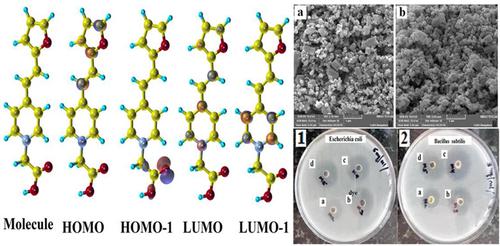当前位置:
X-MOL 学术
›
J. Chin. Chem. Soc.
›
论文详情
Our official English website, www.x-mol.net, welcomes your
feedback! (Note: you will need to create a separate account there.)
Microwave‐assisted synthesis of water‐soluble styrylpyridine dye‐capped zinc oxide nanoparticles for antibacterial applications
Journal of the Chinese Chemical Society ( IF 1.6 ) Pub Date : 2019-08-08 , DOI: 10.1002/jccs.201900029 Manjunath Giridhar 1 , Halehatty S. Bhojya Naik 2 , Chatnalli N. Sudhamani 2 , Mustur C. Prabakara 2 , Rajappa Kenchappa 2 , Nagaraju Venugopal 2 , Sameer Patil 3
Journal of the Chinese Chemical Society ( IF 1.6 ) Pub Date : 2019-08-08 , DOI: 10.1002/jccs.201900029 Manjunath Giridhar 1 , Halehatty S. Bhojya Naik 2 , Chatnalli N. Sudhamani 2 , Mustur C. Prabakara 2 , Rajappa Kenchappa 2 , Nagaraju Venugopal 2 , Sameer Patil 3
Affiliation

|
ZnO nanoparticles were successfully synthesized using a microwave method, whose surface was modified with {4‐[(E)‐2‐(furan‐2‐yl)ethenyl]pyridin‐1‐ium‐1‐yl}acetate as a capping agent (1 and 3%). Their structural properties were investigated using FTIR, XRD, SEM, EDS, and UV–visible spectroscopy. XRD confirmed the Wurtzite structure for all compounds, a size of 30.6 nm for uncapped and 22.9 nm for 3% dye‐capped nanoparticles were calculated from Scherer's equation. Hexagonal wurtzite shape of nanoparticles can be clearly seen in the SEM images. The DFT calculations were carried out using quantum espresso. These dye‐capped ZnO nanoparticles were proved to be potential antibacterial agents, the minimum concentrations of dye‐capped ZnO nanoparticles that inhibit the growth of bacteria are 1.5 mg/mL for Escherichia coli and 0.78 mg/mL for Bacillus subtilis, which are much lower than those of uncapped ZnO. The bioactivity data suggest these organic–inorganic hybrid nanoparticles emerged as a new class of antibacterial agents.
中文翻译:

微波合成水溶性苯乙烯基吡啶染料包覆的氧化锌纳米粒子用于抗菌应用
使用微波方法成功合成了ZnO纳米颗粒,其表面用{4-[((E)-2-(呋喃-2-基)乙烯基]吡啶-1-1-基-1-基}乙酸酯作为封端剂进行了修饰( 1和3%)。使用FTIR,XRD,SEM,EDS和UV-可见光谱对它们的结构特性进行了研究。XRD证实了所有化合物的纤锌矿结构,未封端的尺寸为30.6 nm,染料封端的3%纳米颗粒的尺寸为22.9 nm。在SEM图像中可以清楚地看到纳米粒子的六角纤锌矿形状。DFT计算是使用量子浓缩咖啡进行的。这些染料封端的ZnO纳米颗粒被证明是潜在的抗菌剂,其抑制细菌生长的染料封端的纳米ZnO颗粒的最小浓度是1.5毫克/毫升为大肠杆菌枯草芽孢杆菌为0.78 mg / mL ,远低于未封端的ZnO。生物活性数据表明,这些有机-无机杂化纳米颗粒是一类新型的抗菌剂。
更新日期:2020-02-14
中文翻译:

微波合成水溶性苯乙烯基吡啶染料包覆的氧化锌纳米粒子用于抗菌应用
使用微波方法成功合成了ZnO纳米颗粒,其表面用{4-[((E)-2-(呋喃-2-基)乙烯基]吡啶-1-1-基-1-基}乙酸酯作为封端剂进行了修饰( 1和3%)。使用FTIR,XRD,SEM,EDS和UV-可见光谱对它们的结构特性进行了研究。XRD证实了所有化合物的纤锌矿结构,未封端的尺寸为30.6 nm,染料封端的3%纳米颗粒的尺寸为22.9 nm。在SEM图像中可以清楚地看到纳米粒子的六角纤锌矿形状。DFT计算是使用量子浓缩咖啡进行的。这些染料封端的ZnO纳米颗粒被证明是潜在的抗菌剂,其抑制细菌生长的染料封端的纳米ZnO颗粒的最小浓度是1.5毫克/毫升为大肠杆菌枯草芽孢杆菌为0.78 mg / mL ,远低于未封端的ZnO。生物活性数据表明,这些有机-无机杂化纳米颗粒是一类新型的抗菌剂。











































 京公网安备 11010802027423号
京公网安备 11010802027423号